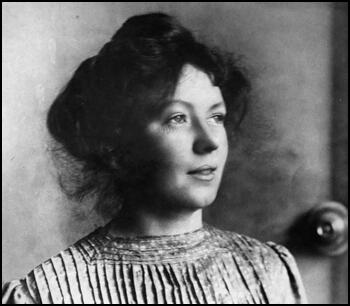The Women's Party
On 2nd November 1917, Emmeline Pankhurst and Christabel Pankhurst changed the name of the Women's Social and Political Union to the Women's Party. (1) Its twelve-point programme included: (a) A fight to the finish with Germany. (b) More vigorous war measures to include drastic food rationing, more communal kitchens to reduce waste, and the closing down of nonessential industries to release labour for work on the land and in the factories. (c) A clean sweep of all officials of enemy blood or connections from Government departments. Stringent peace terms to include the dismemberment of the Hapsburg Empire." (2)
The Women's Party also supported: "equal pay for equal work, equal marriage and divorce laws, the same rights over children for both parents, equality of rights and opportunities in public service, and a system of maternity benefits." Christabel and Emmeline had now completely abandoned their earlier socialist beliefs and advocated policies such as the abolition of the trade unions. (3)

David Lloyd George commented to Andrew Bonar Law, that the Women's Party had been very useful in the fight against the Labour Party: "The Women's Party... has been extremely useful, as you know, to the Government especially in the industrial districts where there has been trouble during the last two years. They have fought the Bolshevik and Pacifist element with great skill, tenacity and courage." (4)
Christabel Pankhurst became one of the seventeen women candidates that stood in the 1918 General Election. She was the only candidate of the Women's Party. She contested Smethwick, and the Conservative Party candidate agreed to stand down so it could be a straight fight with the Labour Party. Her alliance with the Conservatives brought her into conflict with Sylvia Pankhurst, who was a committed socialist. (5)
Christabel accused the Labour candidate, John E. Davidson, of being a Bolshevik. Davidson replied that far from being "corrupted and led by Bolshevists' the Labour Party stood for social reform along constitutional lines "without breaking a single window, firing a single pillar-box, or burning down a single church." Davidson beat Pankhurst by 775 votes. (6)
Christabel Pankhurst was very disappointed by the this result and brought an end to the Women's Party in June 1919, and she and her mother joined the Conservative Party. As Melanie Phillips pointed out: "Mrs Pankhurst and Christabel, it turned out, would have no part to play in the long agitation ahead for equality of franchise, pay, opportunity, divorce and inheritance." (7)
Primary Sources
(1) David J. Mitchell, Queen Christabel (1977)
The Women's Party manifesto represented Christabel's only attempt at more or less constructive political thinking. Apart from familiar demands for a total war effort, the "de-Germanization" of Britain, and the protection of Ireland from the "German peril", shoe outlined her National-Socialist idea of how Britain should be run after the war. Her basic principle was that "the interest of the community as a whole transcend that of the employer and the employed and that Parliament as the sole representative of the Nation must have the last word in all questions affecting the relations between Capital and Labour. Workers' control of industry was a dangerous fallacy. There had to be Leaders and Led, though workers must be guaranteed a fair wage and plenty of leisure...
The Woman's Party demanded equal opportunity of employment, equal pay for equal work, equal marriage laws (including equal conditions of divorce), equality of parental rights, the raising of the age of consent, and "equality of rights and responsibilities in the social and political life of the nation".
(2) David Lloyd George, letter to Andrew Bonar Law (21st November, 1918)
The Women's Party... has been extremely useful, as you know, to the Government especially in the industrial districts where there has been trouble during the last two years. They have fought the Bolshevik and Pacifist element with great skill, tenacity and courage.

